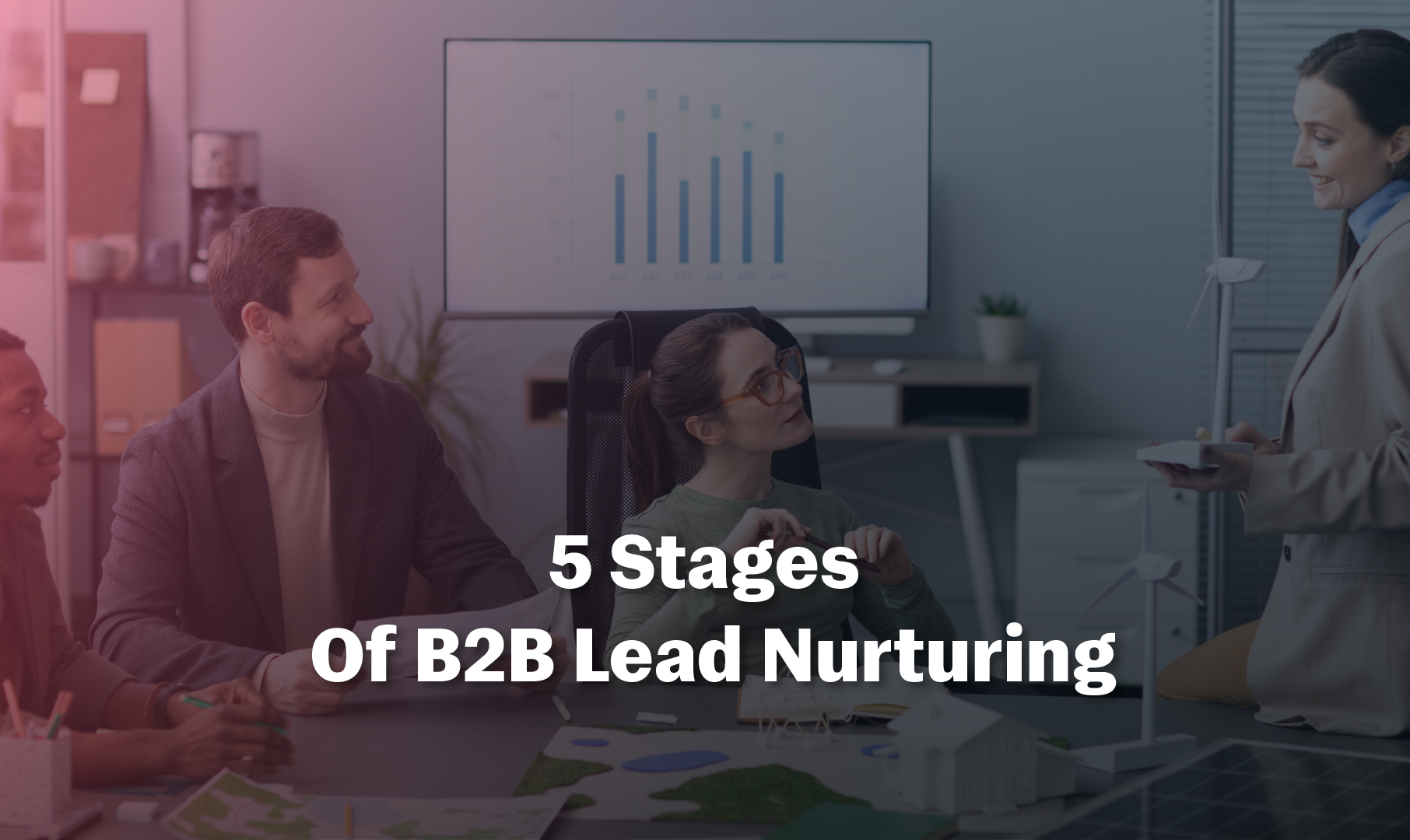Nurturing B2B Leads: From Awareness to Conversion for Scalable Success

Nurturing B2B Leads: From Awareness to Conversion for Scalable Success
Did you know companies that excel at lead nurturing generate 50% more sales-ready leads at 33% lower cost? B2B lead nurturing is the heart and soul of a successful lead generation workflow. It turns your boring and long sales process into an effective way of connecting with your leads and turning them into life-long customers.
As we all know, the toughest part of running a business is bringing in leads and eventually turning them into sales. To create a good return on investment (ROI), you need to have a strategy that helps your prospects move down the sales funnel smoothly.
With the right lead nurturing strategy, you’ll boost your B2B sales process and build lasting relationships. So, let’s dive in and turn awareness into conversions and set your business up for success.
What is lead nurturing?

Lead nurturing is all about listening to the needs of your prospects at every stage of your B2B sales cycle and communicating solutions to them to build trust and maintain a connection. This process is key to turning prospects into paying customers.
Nurturing leads is critical to your business’s success because these tactics directly influence whether customers decide to convert. There are several ways to nurture leads including targeted content, multi-channel nurturing, multiple touches, timely follow-ups, and personalization.
For example, a fitness app offered free trials with personalized workout plans based on users’ goals. Follow-up emails offered tips and challenges, keeping users engaged, which led to a 30% conversion rate from trial users to paying subscribers.
However, many marketers find it challenging to create the right strategy. The 2019 Lead Nurturing & Acceleration Survey revealed that 60% of respondents felt their programs were lacking. This means there’s a significant opportunity for those who can master lead nurturing to stand out and gain an edge over the competition.
So, how can you ensure your lead nurturing strategy is effective? Let’s explore the key elements that make a successful B2B lead nurturing campaign.
Key Elements of a B2B Lead Nurturing Campaign
- Understand Buyer Personas: Identify what your ideal prospects want to achieve at work by basing your buyer personas on your existing customer base. Companies with well-defined buyer personas experience a 73% higher average deal size and a 28% faster sales cycle, according to SiriusDecisions.
- Personalize: Personalization is crucial. Send informal, personalized emails, address prospects by name, and use a conversational tone to build a stronger connection.
- Educate Your Prospects: Help your prospects navigate their buying journey by educating them at each phase:
- Awareness: Share blog posts and industry trends.
- Consideration: Invite them to webinars or demos.
- Decision: Share customer success stories and testimonials.
- Retargeting: Use push notifications and dynamic calls-to-action to re-engage prospects. For instance, Ubisoft saw a 17% click rate using VWO Engage.
- Avoid Spamming: Don’t bombard prospects with daily emails. Find the right follow-up frequency and segment your contacts by traits like job title, age, location, and interests.
- Start Early: Begin nurturing leads as soon as they engage with any part of your business, even if it’s just your blog content.
- Use Content Marketing: Address prospects’ pain points with thoughtful content. This builds trust and establishes your authority in the industry.
5 Stages Of B2B Lead Nurturing
After understanding the basics, let’s break down lead nurturing into five stages and learn about it in depth.


Stage 1: Spreading Awareness Through Content
Are you effectively addressing your consumer pain points? Use newsletters, whitepapers, blogs, and landing pages to capture leads and make your target audience more aware of your brand.
For example, a tech company might create a series of blog posts and whitepapers on the latest industry trends and innovations, using these as lead magnets on landing pages to capture contact information and build an email list.
Stage 2: Nurturing Top of The Funnel Prospects
In this stage, we give deeper insights to prospects about the brand and its expertise. It focuses on creating long-term nurture programs that offer resources like Ebooks, white papers, introductory webinars, etc. For instance, a SaaS company might offer free eBooks on industry trends to educate potential clients about their offerings and hold introductory webinars to explain how their software solves common industry problems.
This stage is essential as it caters to new leads and those that might have bounced back from the middle of the funnel. With the help of monitoring metrics, you can optimize the frequency of emails and gently move your prospects to the next stage.
Stage 3: Nurturing Middle of The Funnel Prospects
Stage 3 starts by offering potential clients conversion-focused content related to offered products and services. Marketers use different email nurture campaigns like booking sequences or demo sequences to set up a direct meeting with the prospect.
Such sequences include a clear CTA and sometimes a lead magnet to attract clients and urge them to click. To establish your credibility, you can also have client testimonials, other social proofs, and such content.
Stage 4: Converting the Bottom of The Funnel Leads
Now the leads are warm enough to engage with direct sale CTAs. At the bottom of the funnel, you can offer free consultations and advanced webinars that can make the prospect more confident about services.
For instance, a marketing agency might offer a free consultation call to discuss a custom marketing plan, followed by an advanced webinar on maximizing ROI through their services.
Stage 5: Nurturing Existing Customers For Retention
Lead nurturing campaigns do not end when the lead gets converted, but it is always ongoing. By communicating with your existing customers monthly or weekly, you can develop a healthy working relationship with them. Your nurturing sequences can include additional discounts, upgrade offers, etc.
A good customer retention score helps you gain more referrals, build a better brand reputation, and higher customer lifetime value. It also brings in the opportunity to upsell and cross-sell.
Having covered the stages, let’s now focus on the key KPIs to measure the effectiveness of your B2B lead nurturing strategy.
Key KPIs for B2B Lead Nurturing Strategy
Monitoring your lead nurturing efforts closely is key to achieving success. Here are the important metrics to focus on:
- Email Unsubscribe Rate: This tells you how well your emails are connecting with your audience. Adjust your content and how often you send emails based on unsubscribe rates.
- Lead Tracking: Compare marketing-qualified leads (MQLs) to sales-qualified leads (SQLs). MQLs show interest and are in the middle of the buying process, while SQLs are ready to buy. This helps you see how well your campaign is converting leads into sales.
- Email Click-Through Rate (CTR): A high CTR indicates that your audience finds your content engaging. It reveals which messages resonate best with your prospects.
- Sales Cycle Length: Measure how quickly leads become customers. A shorter sales cycle signifies an efficient nurturing strategy. Establish a benchmark and monitor your progress over time.
- Return on Investment (ROI): High ROI means your nurturing efforts are paying off. It calculates how profitable your campaigns are, considering costs like lead generation and acquisition.
By focusing on these KPIs, you can refine your lead nurturing strategy and drive promising results.
Tools to Boost Your Lead Nurturing Journey
There are many tools out there to help with lead nurturing, but here are three of the most popular ones:
Zendesk Sell
Zendesk Sell is an online tool that helps businesses keep track of their sales process. It lets you send personalized messages to leads, manage everything from one place, and predict future sales, making it a great tool for turning leads into customers. It excels in sales pipeline management, tracking leads, predicting sales, and keeping your sales team organized. Zendesk Sell also focuses on sales activity tracking like calls and emails.
Distinct Advantage: Best suited for sales teams looking for comprehensive pipeline visibility and management.
Mailchimp
Mailchimp is a well-known B2B email marketing platform that helps businesses create, manage, and send email campaigns. It features lead segmentation, automated emails based on user actions, and detailed reports to improve campaigns. Mailchimp specializes in email campaign creation, management, and analytics, enabling segmented email campaigns and automated sequences based on lead behavior.
Distinct Advantage: Ideal for marketers prioritizing email campaigns and audience engagement through personalized content.
WebEngage
WebEngage is a B2B marketing tool designed to engage and retain users across various channels. It sends automated emails based on specific actions, like visiting a webpage or downloading a white paper, and creates personalized landing pages tailored to each lead’s interests. WebEngage goes beyond email, offering a multi-channel engagement platform that triggers personalized messages across email, SMS, push notifications, and website content based on user behavior.
Distinct Advantage: Perfect for businesses looking to engage users across multiple touchpoints beyond just email.
By leveraging these tools, you can streamline your lead nurturing process and achieve better results.
Conclusion

B2B lead nurturing is all about building the perfect roadmap for generating and retaining leads. It supports your leads throughout their buyer’s journey and creates personalized experiences. By using targeted content, engaging through multiple channels, following up on time, and personalizing your approach, you can significantly boost conversion rates and foster strong customer relationships.
Unlock the full potential of your leads! Transform your lead nurturing strategy with expert guidance from Salessy.ai. Contact us today for a personalized consultation and watch your conversion rates soar!






